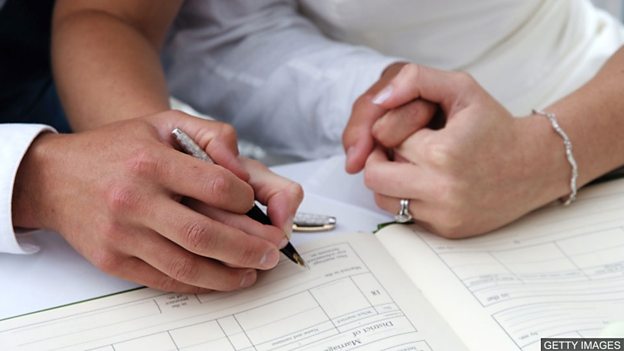在英国,女性婚后随夫姓这个传统已延续了一千多年。然而,这一惯例究竟从何而来?时至今日,婚后从夫姓的现象仍然非常普遍吗?近来,在千禧一代人中,有越来越多的男性选择“夫随妇姓”。本集《随身英语》探讨随着时代发展而演变的命名惯例。
课文内容
Vocabulary: names 词汇: 名字
No one knows how long humans have been giving themselves names, but one thing is sure: surnames are a much more recent idea than given names. In Europe, surnames were developed to distinguish between individuals who had the same moniker. They were brought to the UK by the French nobility following the Norman Conquest around the 12th century and became common around the 14th century.
Another tradition that the Normans introduced was that of coverture. This was a law which said that a woman became a man's property when they got married. In those days, only a man could be the head of the family and allowed to own property. At this point the bride lost her maiden name. Over time, this has led to the tradition that upon marriage a woman relinquishes her maiden name and takes on her new husband’s family name.
Fast forward to the present. These days a woman choosing not to change her name to match her husband’s after marriage has long been a norm. The first recorded case is widely believed to be an American suffragette called Lucy Stone. When she got married in 1855, she refused to take her husband's name. After that, other ideas such as merging and double-barrelling also became common.
However, it would seem that a new trend is arising. One in ten millennial males is now electing to replace their surname with their wife’s. That's according to a recent study of 2000 UK adults by Opinium, a strategic insight agency. In a BBC article, Rory Dearlove née Cook, explained that for him it wasn’t important to keep his surname. He thought it would be nice for his wife and him to have the same last name. The bride, Lucy, had made it clear before getting married that she had no intention of changing hers, but thought that he would keep his too. “He's entitled to keep his just as I am entitled to keep mine,” she commented.
Other men had different reasons. Charlie Shaw, dubbed 'Morley' at birth, explained that it was, “a gesture of allegiance and an opportunity to acknowledge the unseen patriarchal bias and sexism in our society.” It’s worth noting that, in the UK at least, only the fathers of the couple being married are on the marriage certificate. The mothers do not appear at all.
However, not everyone is in favour of altering tradition. Rachel Robnett, a researcher at the University of Nevada, surveyed a number of people in the US and UK and found that a man whose wife keeps her maiden name is viewed as ‘feminine’, while the woman was believed to ‘wear the trousers’. And when one family found out that their son was to take his wife’s name, they refused to attend the wedding. To them it was proof that he was totally under the thumb.
‘What’s in a name?’ Shakespeare asked in Romeo and Juliet. It would seem, depending on who you talk to, a great deal. Whether maintaining traditional naming conventions, keeping the surname, or swapping names, these days at least there is a choice to be made.
词汇表
surname 姓,同“family name”
given name 名
moniker 人名、绰号
maiden name(女性婚前的)娘家姓
family name 姓,同“surname”
take her husband’s name 随夫姓
merge 合并组成
to double barrel 双方联姓的
née(已婚女性的姓氏后标注的)原姓
keep one’s surname 保持某人的原姓
dub 称…为,叫作
take his wife’s name 随妇姓
naming convention 命名惯例
swap name 替换名字
测验与练习
1. 阅读课文并回答问题。
1. Why were surnames first developed?
2. Apart from surnames, what other idea did the Normans introduce to the UK?
3. Why did Charlie Shaw decide to take his wife’s name?
4. What did the survey by Rachel Robnett suggest about how people viewed a man who allowed his wife to keep her maiden name?
5. Which word in the article means ‘has the right to do’?
2. 请在不参考课文的情况下完成下列练习。选择一个意思合适的单词填入句子的空格处。
1. After I married, I became Samantha Jones. I’m Samantha Jones ______ Johnson.
Née moniker maiden name merge
2. He was awarded a knighthood in 2005 and was ______ Sir John Smith.
née dubbed given name double-barrelled
3. I want to combine our names to make a ______ one. Should I be Smith-Parker, or Parker-Smith?
merged given name double-barrelled kept
4. In some places, ______ are based on the female line. You follow the mother’s name.
keeping his surname taking her husband’s name moniker naming conventions
5. I’m sorry. I’m Stephanie Jones now. Waters was my ______.
naming convention maiden name née moniker
答案
1. 阅读课文并回答问题。
1. Why were surnames first developed?
In Europe, surnames were developed to distinguish between individuals who had the same moniker.
2. Apart from surnames, what other idea did the Normans introduce to the UK?
Coverture, which was a law which said that a woman became a man's property when they got married.
3. Why did Charlie Shaw decide to take his wife’s name?
He said it was “a gesture of allegiance and an opportunity to acknowledge the unseen patriarchal bias and sexism in our society.”
4. What did the survey by Rachel Robnett suggest about how people viewed a man who allowed his wife to keep her maiden name?
It suggested that a man who allows his wife to keep her maiden name is viewed as ‘feminine’, while the woman was believed to ‘wear the trousers’.
5. Which word in the article means ‘has the right to do’?
Entitled. (“He's entitled to keep his just as I am entitled to keep mine,” she commented.)
2. 请在不参考课文的情况下完成下列练习。选择一个意思合适的单词填入句子的空格处。
1. After I married, I became Samantha Jones. I’m Samantha Jones née Johnson.
2. He was awarded a knighthood in 2005 and was dubbed Sir John Smith.
3. I want to combine our names to make a double-barrelled one. Should I be Smith-Parker, or Parker-Smith!
4. In some places, naming conventions are based on the female line. You follow the mother’s name.
5. I’m sorry. I’m Stephanie Jones now. Waters was my maiden name.












